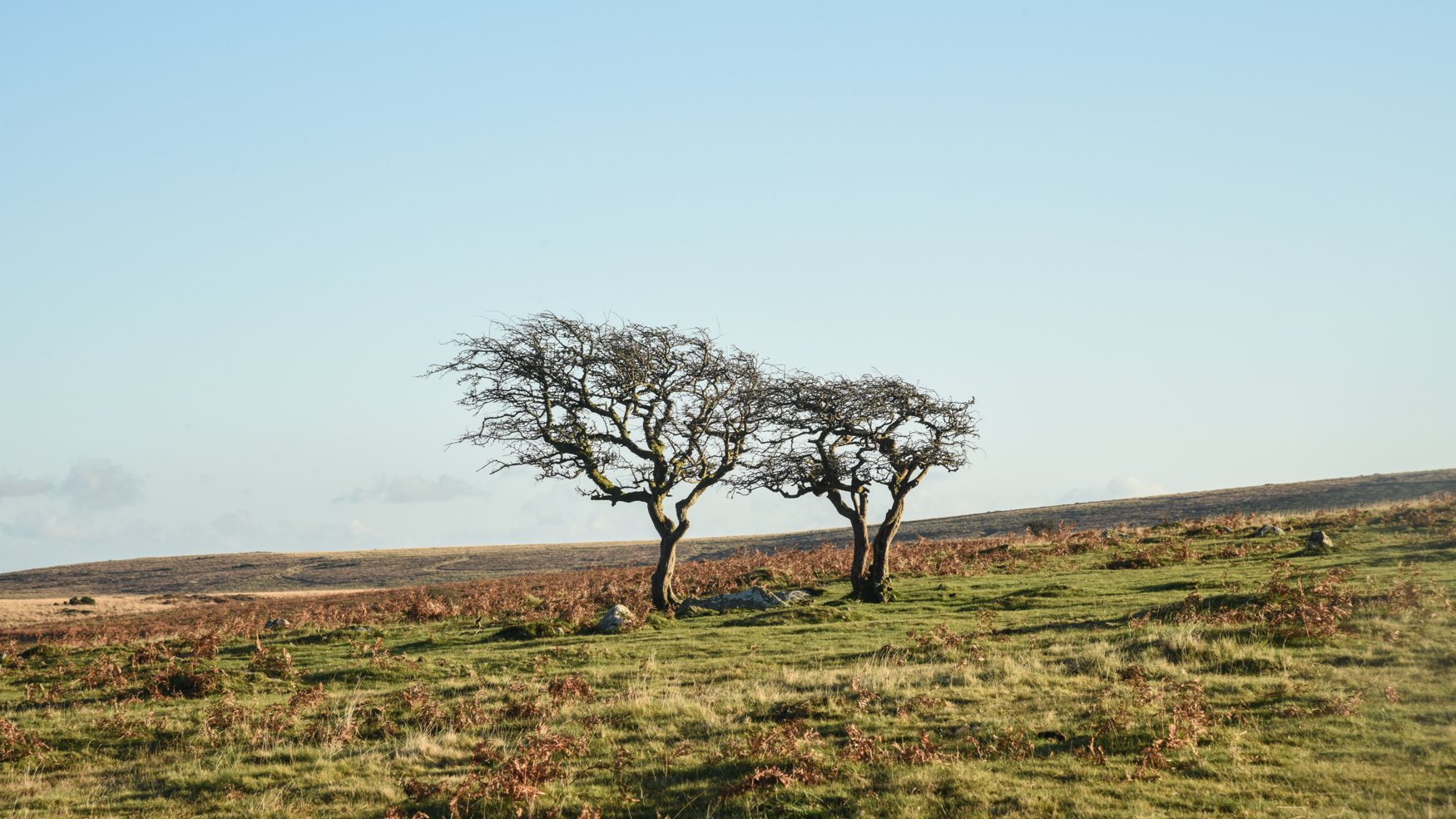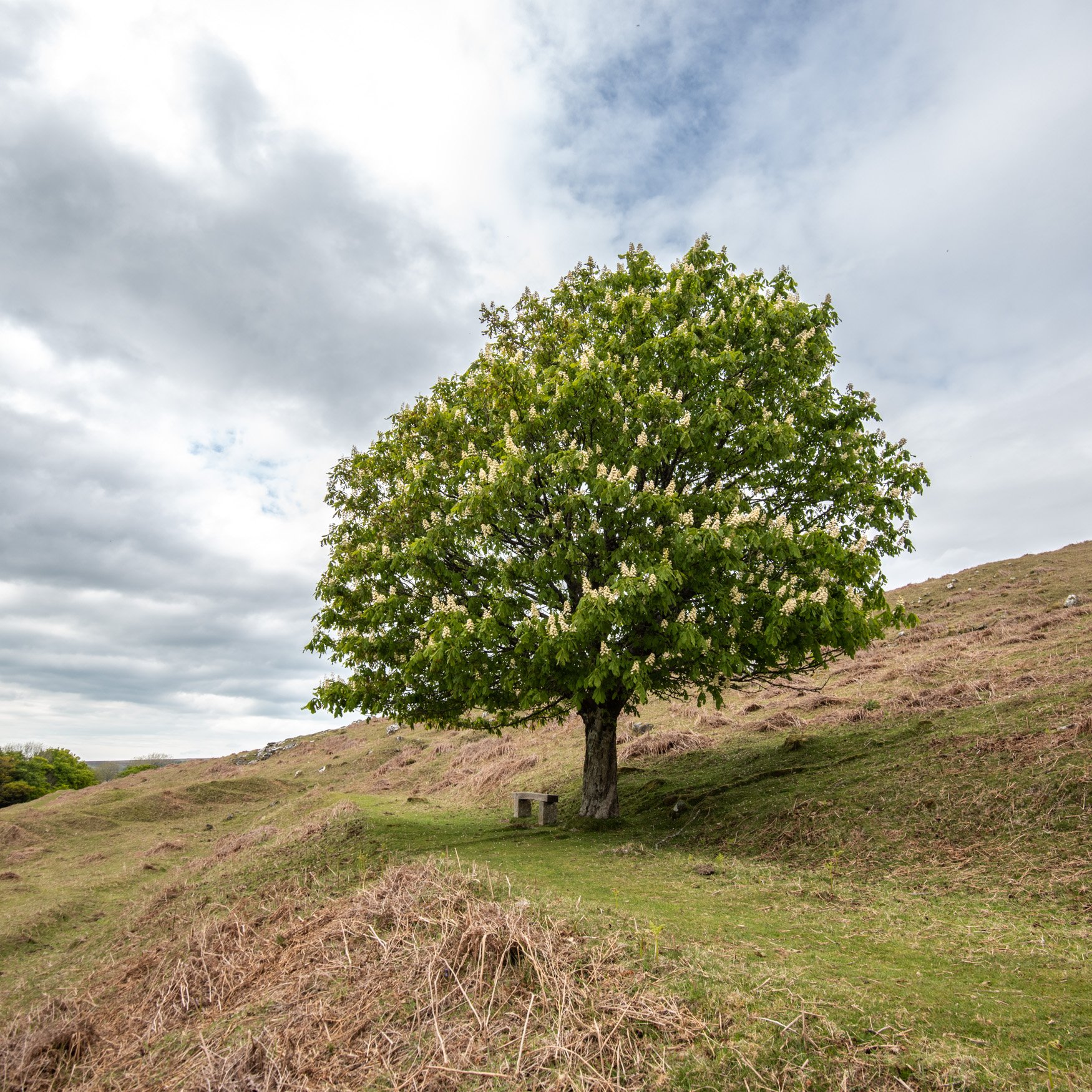Counting Trees
With Jez Ralph, Director ‘Evolving Forests’.
June 2022
You might look at the high moors of Dartmoor and wonder where the trees are. And if so, you’re not alone. Jez Relph, who has built up a team with Corylus Ecology and taken on the task of surveying open trees on three of Dartmoor’s commons, admits. ‘I think it's fair to say that when we took on the job, we thought it was going to be easy, as there seem to be so few trees on Dartmoor.’ But once they started looking, they realised there were many more trees than expected. ‘We've been totally amazed - we've surveyed well over 2000 trees so far on the small section of moor we are working on, and we're only halfway through.’
This survey that’s being done as part of the larger Our Common Cause project, involves more than twenty volunteers and covers three commons (Harford, Ugborough and Holne). It will be filling a gap in knowledge - no-one has ever surveyed trees growing on the open moors before. Each tree is located using GPS, photographed, measured and given a health assessment.
According to what the surveying team has found so far, Jez tells us that hawthorns account for roughly 80% of the trees. Of the other 20%, rowan is probably the most common, and where streams flow, there are mainly alders and willows. There are also hollies, and some big oaks and beech trees, many of which are located on boundaries. While we’re talking, we’re standing beneath a magnificent oak, on the edge of Harford Moor. It seems to be the only sensible place to be, as rain is falling heavily. We’re thankful for this veteran tree, but mindful too that you only get old trees from young trees with a good future ahead of them. The range of ages of trees is one of the things the survey is looking at.
‘Through this survey we want to get an assessment of the overall health and number of trees, including saplings and where regeneration occurs. As an example, we surveyed one area that had been burnt off during some of the annual burning. Amongst that were hundreds of Rowan seedlings, which had been protected from grazers by the gorse. Knowing things like that helps us consider that if in the future we wanted to increase woodland cover or create a more naturalistic flow from high forest through to open moor, what techniques might help saplings survive.’
Jez and the wider team will be continuing the survey over the course of two summers. While that may sound like a long time, it’s quite restricted; they need to do it when trees are in leaf, and before bracken grows so high that it hides saplings from view.
The volunteers include commoners and land owners who, says Jez, ‘have a rich, long history of noticing everything that happens on the land here.’ There are also students, people who’ve done a lot of volunteering, and some who have never volunteered before but wanted to learn. ‘It's amazing to come out with people who don't know a hawthorn from an oak, and to give them something to do that's useful for us, useful for the environment, and helps them learn.’ The team’s WhatsApp groups have been incredibly vibrant. ‘Just as important as the data is the fact that the public and owners and commoners have been able to come together. We've been blown away by the enthusiasm, and the amount of time people have spent out on the moor - days and days surveying.’
I’m getting an image in my head of people setting out onto the moors to find trees, and soon disappearing from view, in this vast and wide-open landscape. It’s a little like gathering sheep. At first, you think there are only one or two, but the longer you’re out there, the more you see. With sheep, the counting and monitoring tends to happen when they are in the yards. With the trees, I wonder, how is all the information being stored?
‘We could have gone down the route of using paper copies,’ says Jez. ‘You can imagine on a day like this, in the pouring rain, we’d just have papier-mâché! And we'd have 4000 bits of paper that would then need to be filed and catalogued. So we decided to go digital: we're using something called Cloud GIS, which is a really intuitive, easy-to-use app and we’ve developed a very simple form.’
Anyone taking part in the survey can use this form to note the type of tree, it’s apparent state of health, and any lichens that might be present on it. Making use of modern technology, location is automatically recorded when a photograph of the tree is taken. The height is measured as a rough estimate by photographing the tree with a metre-stick set against it, and the diameter is also measured roughly. ‘What we're looking for is not exact diameters or heights. We're looking for patterns - is there a pattern of health issues or age-classes? For example, one thing we've noticed is that many of the rowan trees in this area are unhealthy.’
Jez explains the process in more detail. ‘An intrinsic part of the project is to take this data and ask what it means for the future. This is partly a discussion between the people that use the moor, and will partly be dictated by the climate and the conditions here.’ There are some findings, however, that are beginning to show useful patterns. ‘Seventy percent of all the trees we've surveyed,’ says Jez, ‘are in the mature or dying category. In a typical woodland, you'd expect seventy percent of trees to be young, to have a lot of saplings. Though this is not a woodland, perhaps we should be trying to encourage regeneration in some areas to create a better balance of ages.’
The team are hoping to carry out some small-scale experiments to learn about conditions for regeneration. ‘We will, hopefully, plant two or three very small experimental trials, probably of the species that we find most commonly up here. It might be that one small area is fenced and left; another area might not be fenced at all, but we could use tree tubes; another could be densely planted and then thinned out once the trees are established. We're not talking about foresting Dartmoor - what we're talking about is creating conditions where there is a more natural tree cover, perhaps forest in the valleys, up through more scattered trees and montane scrubby environments, right up onto the tops and the open moor where there's very little tree cover.’
Our conversation tracks back from future projections to the importance of having data that shows the current state of trees. This ‘baseline’ information is critical going forwards, so that change can be monitored. ‘Someone needs to come back and do this in five or ten years’ time,’ says Jez. ‘and then in another five or ten years’ time again. Only then can you get a proper indicator of what's happening.’
Given the enthusiasm among the project’s volunteers, there’s a chance some of them might choose to do that; there may also be opportunities for funded surveys in the future. Ongoing monitoring is critical, and unfortunately it does not always happen. Perhaps this tree survey will be the first of many, and will also ride the wave of citizen science that is getting more and more people engaged in observing what’s around them, and providing data that can be stored, analysed and used to support choices and decision-making in the future.
Before we give in to the rain and leave our increasingly wet spot under the oak, I ask Jez whether doing this work has made him optimistic about future ecological balance on the moors. ‘There's a note of pessimism, because of the health of the trees,’ he says, ‘but in another way, I’m more optimistic than I thought I’d be. I see the moor now as more of a wood pasture - it might be a very dispersed wood pasture, but there are so many more trees than we thought there would be.’ On a much wider scale, Jez admits we can't stop the forces of nature and climate, not in a lifetime. ‘It's taken us centuries to force the climate to heat up and to change. It will take centuries to reverse that, and we're not going to fix that alone in this generation. But society is still going to be here, and we’re still going to need trees. So looking after trees, and helping a bit, has to be a good thing.’
For more information on other work Jez and his team do, see www.evolvingforests.com
Words by Harriet Fraser, Images by Rob Fraser










